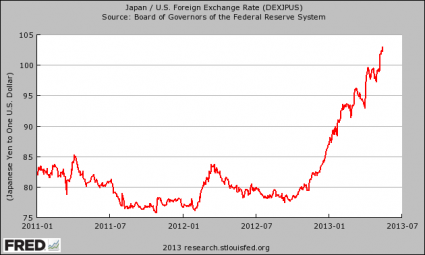Today's session depends on the outcome of the meeting of the Fed. As we already know, when the market doesn't like the news, it enters in a strong depression. But for today, it's unlikely to happen. After the words of different Fed chairmen of some important states, it is clear that this policy will continue to search for economic recovery. In fact, Bullard (president of the Chicago Fed) has recovered the EMU economic policy in addition to other presidents, who said they know that it is not currently feasible to change the monetary policy. A couple of positive notes, is that Linkanen (ECB) recommended the purchase of ABS as a way to promote lending to SMEs, as well as the confirmed approval of a shield to 100,000 € in deposits. All these measures should encourage equities, so I expect a higher open, but as always, rumors and words from Bernanke will be conditioning the session.
The
U.S. market had a downward trend in the beginning of the session, after words of different authorities, but it changed its sign compensating losses in the European market. The increases were very limited because markets are still with doubts about Bernanke's words. The better was the DOW with a rise of 0.3% followed by SP and NASDAQ, which rebounded 0.2%. Dudley (San Francisco Fed) and Bullard (Chicago Fed) encouraged the market making it clear that they are strongly opposed to the completion of the QE.
The
European session ended mixed yesterday. Profit taking, as I had already said, is always given in the markets that generate more doubts, such as the Spanish and the Italian (fell -0.6% and -0.5%). The best performing was the FTSE100, which was encouraged with its retail sales.
In
Asia, the behavior of the stock exchange remains bullish due to the expansionary measures of the BOJ. This morning, they have spoken again about the continuation of these same monetary policy, which caused a large rise in the Nikkei that finished with a rebound of 1.6%.
For today's session I expect an upward trend, but depending on Bernanke's words. About that time, the volatility will rise and depending on the way of putting it, the market will take it in one way or another, although it seems clear that they will continue with the same policy. For the medium and long term I continue expecting a bull market.
INDICES:
S&P 500
The world looks today to Wall Street. On the day before the hearing of Bernanke, the maximum was beaten again, reaching up to 1672 points. After the brief correction of the last hours and the new minimum volatility, I continue to see the index rising across all maturities. However, we should be aware of a possible rupture of support that could give us trend exhaustion symptoms.
Dax 30
The German index leaves an interesting perspective on the hourly chart. I expect an upward trend as long as it trades above the 50-day average. However this is a value to be careful because, despite the strength of the trend, the maximums are decreasing, what makes me think that a possible correction in medium term do not may be too far away.
Ibex 35
With markets awaiting Bernanke, the Spanish index faces a day in which it will look askance at what happens on the other side of the Atlantic. Despite the higher open today, what really made the gap was the rising above of the average of 14 sessions, and the IBEX remains in a channel between 8377 and 8598 values. We must be very attentive especially to the supports because if they get lost, it will mark a target of 8130. However, with controlled volatility and a higher open, today it's unlikely to reach those levels.

















































